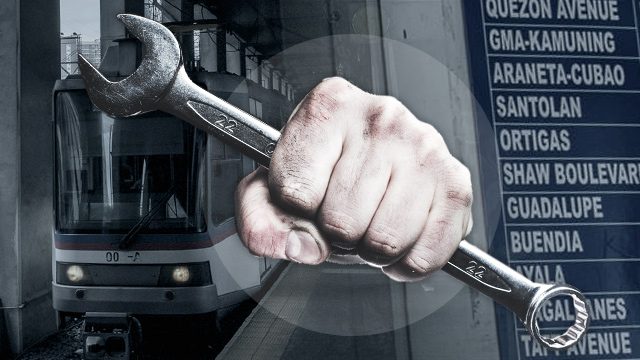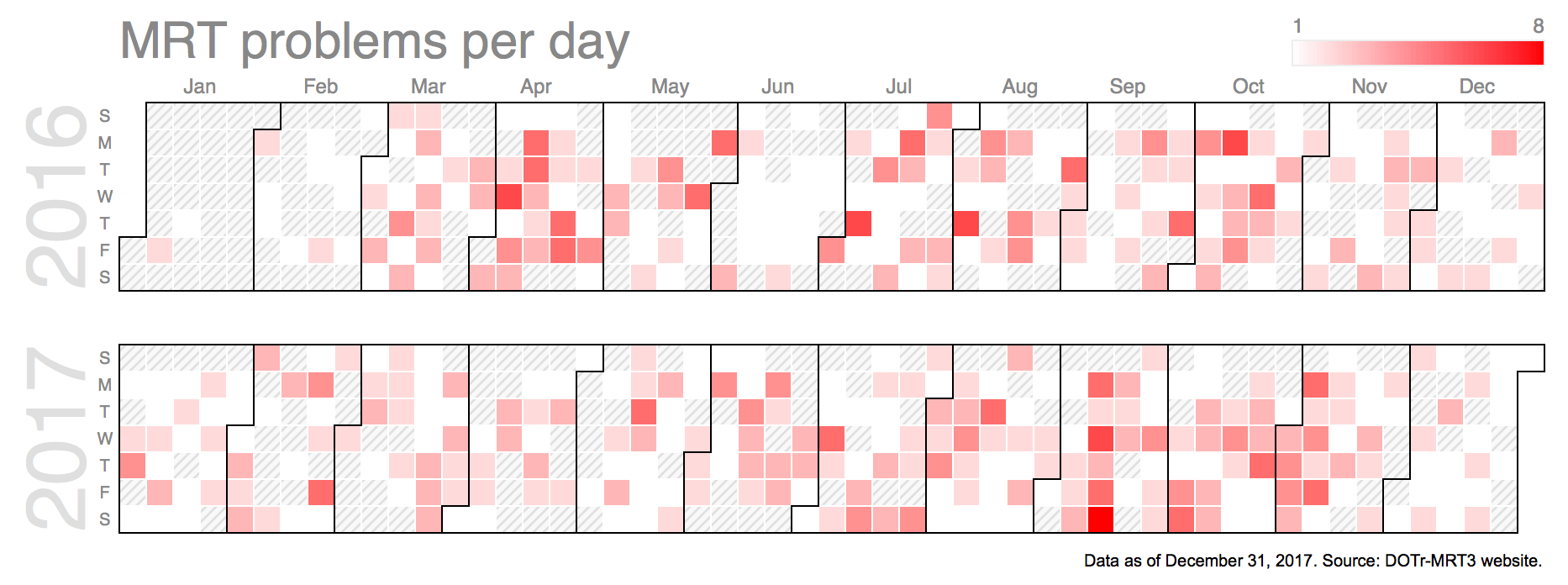SUMMARY
This is AI generated summarization, which may have errors. For context, always refer to the full article.

MANILA, Philippines (UPDATED) – In the last few weeks, there’s been an abundance of news about glitches, accidents, and all sorts of problems involving the Metro Rail Transit (MRT) Line 3, which serves EDSA, Metro Manila’s main artery.
For instance, on Thursday, November 16, a train coach was detached from the train body between the Ayala Avenue and Buendia stations.
Even on the last day of 2017, the MRT broke down and unloaded passengers “due to a signaling problem”.
Besides those incidents, there have been reports of train failures, disruption of full operations, and a few incidents where trains stopped between stations, forcing passengers to gingerly and perilously walk along the MRT tracks.
How often do these irritating MRT incidents happen? Is there a pattern to the mishaps and glitches? We looked at the available data to find out.
More glitches this year
The data shows that there are more MRT glitches and problems recorded in 2017, compared to 2016.
This is evident in data posted by the Department of Transportation (DOTr), which has jurisdiction over the MRT3. DOTr has posted service status notices on its website from November 2015 onwards.
We filtered notices related to MRT service interruptions, unloading of passengers, and provisional services. We excluded statuses referring to the resumption of normal services and a few other details that are either connected to a previous status or do not necessarily entail an interruption.
Provisional service refers to a temporary disruption of full operations, when trains are unable to run from end to end, and instead run shorter distances between stations.
From January 1 to December 31, 2017, there have been 516 MRT3 problems already recorded, an average of 9.92 – almost 10 a week – or more than once a day on some days. Of this number, 449 are train offloading incidents, 38 are service interruptions, and 29 are provisional services.
In 2016, only 441 incidents were recorded in the MRT3 line, or an average of around 8.5 a week.
In 2017, MRT3 problems have become more frequent, taking place with higher frequency each month, too. April and December had the lowest number of incidents, with 29 each. But between those months, there had been an upward trend per month, peaking in September with 61. The following month of October had 54 incidents, but November matched it with 55.
Since 2016, the most number of MRT problems took place in April 2016, with 63, just a couple more than what was recorded in September 2017.
Danger hours
Looking at per-hour data in 2017, more incidents take place during the morning rush hour (peaking at 45 incidents from 8 am to 8:59 am). Glitches are also more common from 2 pm to 5:59 pm.
Taking all the data since 2016, incidents usually happen at 6 am and 8 am. Afternoons are generally also prone to problems.
The latter half of the week tends to see more MRT problems. Wednesdays are typically bad MRT days in 2017, with 96 incidents recorded, followed by Thursday (86) and Friday (82).
Below is a chart of MRT problems per day recorded since 2016. Notice the high frequency of incidents in April 2016, October 2016, September 2017, and October 2017.
You’ll see that the 2nd week of September 2017 was the worst week with a total of 29 incidents, more than any other full week. In fact, September 16, 2017 (seen below as the box with the darkest color) has, so far, the most glitches in a single day, with 8.

Per station
According to data from the DOTC-MRT3 website, most of the train unloading incidents in 2017 took place at the Cubao station, happening 58 times, commonly due to technical problems. The Magallanes station in the south is in second place, at 50 times.
Factoring in 2016 data, passengers were offloaded more frequently at the Santolan and Cubao stations, at 95 and 93 times, respectively, so far. Ortigas and Magallanes tie at third with 91.
Service interruptions between stations
As for 52 service interruptions between stations since 2016, most have been recorded as occurring between the North Avenue and Quezon Avenue stations. A total of 16 interruptions have taken place there: 7 in 2016, and 9 in 2017.
Stations that recorded 5 or more service interruptions between them are the following:
- Ortigas – Santolan: 8
- Ayala Avenue – Buendia: 5
- Cubao – Santolan: 5
There have also been service interruptions listed by DOTr-MRT3 in specific stations, with 15 such incidents in 2016 and 12 in 2017. Many of these were reported to have occurred at the North Avenue station (with 8 in 2016 and 4 in 2017).
Since 2016, the number of service interruptions have increased, resulting in shortened trips instead of end-to-end operations. When will these woes end? – Rappler.com
Add a comment
How does this make you feel?
There are no comments yet. Add your comment to start the conversation.